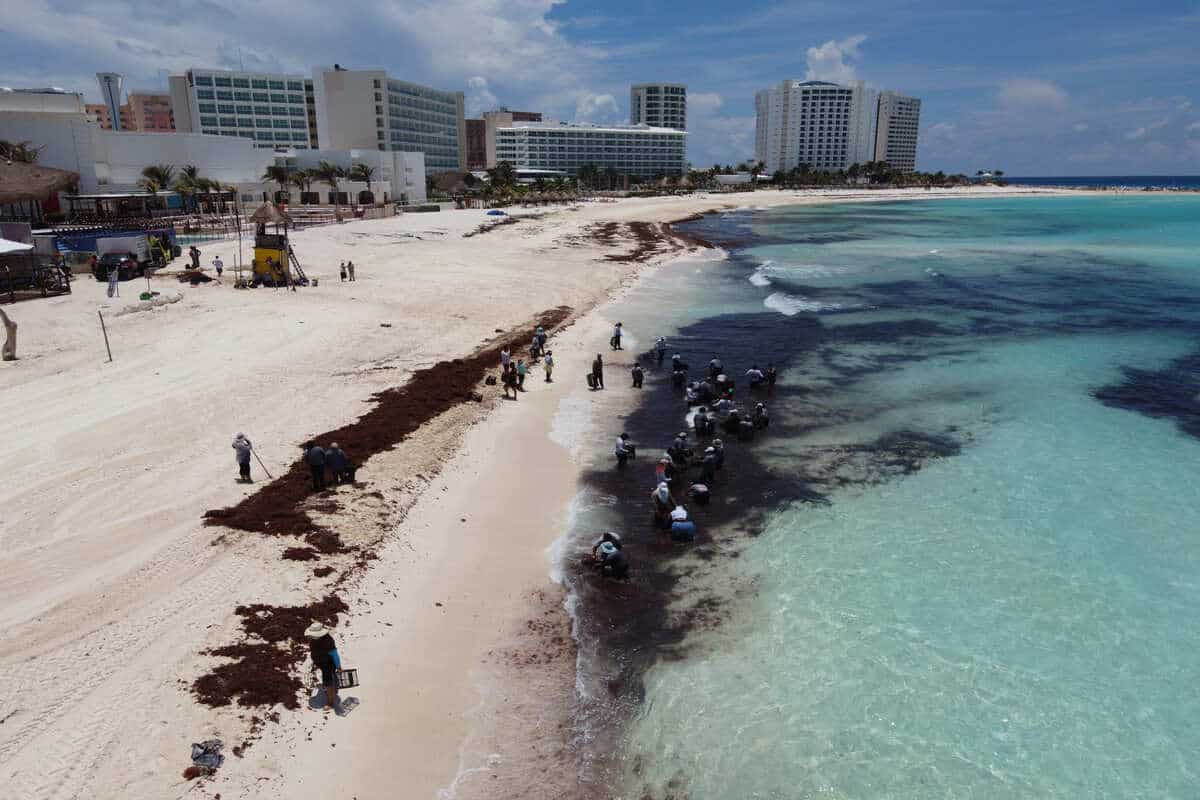Cancun may have established itself as the world’s top vacay hotspot, but sargassum remains its biggest foe. The Mexican city, home to an array of luxury resorts and cultural attractions, has been battling the phenomenon for the better part of 2022, with future guests now wondering:
When, exactly, should they book a Cancun getaway to avoid the dreaded seaweed, and how actually dangerous is it?
Yes, Cancun’s coastline isn’t always spotless, unlike what Google would have you believe. The city’s struggles with seaweed pollution have been well documented, and although the Government has made it a top priority to protect beaches, not all sargassum can be diverted from the shore, especially during the infamous ‘sargassum season’.
What Is Sargassum And How Dangerous Is It?

To put it simply, sargassum is harmless to humans. It’s a living organism commonly found in tropical marine ecosystems, like Cancun’s. During its reproductive stage, it never attaches to the seafloor and ends up floating instead, eventually washing up on the shore. Of course, it’s never a pleasant sight when that happens.
Sargassum may not pose any particular health threats, but it does have the power to blemish the look of the Caribbean’s sparkling white sandy banks, as well as impregnate the air with a foul smell, characteristic of seaweed that’s been gathering for days. When cleaning isn’t carried out immediately, this can certainly ruin the whole Caribbean beach experience.

According to Chaunmin Hu, a professor of Optical Oceanography, sargassum season generally lasts from April to August, though some years have seen ‘particularly large blooms’, including 2018 and 2021. Hu attributes the sargassum increase to an increasingly warm Atlatic Ocean, of which the Caribbean is a part of.
Earlier this year, a popular beach in Playa del Carmen had to be sealed off for days due to the unprecedented amount of seaweed, while Cancun fiercely battled to avoid meeting the same fate. Sadly, Hu believes the event has ceased being ‘episodic’ and it’s now a ‘new normal’, even though some ‘peaks’ have been noted.

When’s The Best Time To Visit Cancun?
Although seaweed does tail off by August, as a general rule, Mexico’s coast is usually completely cleared only by November, when the water finally cools down in the Northern Hemisphere and algae reproduction – including sargassum – slows down. Starting in winter, Cancun’s beaches assume their pristine nature once again, making it a perfect time to visit the Mayan Riviera.

This status is maintained until April, roughly, when the temperatures rise and the smelly macro-organism makes a comeback, blanketing beaches once more. Coincidentally, the October-April period tends to be the busiest for arrivals in Cancun, as millions of Americans jet off to the paradise location escaping the bitter cold.
In sum, the best months for visiting Cancun and avoiding the seaweed – though not the crowds – are:
- November
- December
- January
- February
- March
- April
The only downside? Seeing that this period comprises Mexico’s temporada alta, when visitor figures soar past the tens of millions, prices escalate in response. This year, hotel fares have increased by more than 50% in popular sunny destinations, like Miami, due to a widespread worker shortage and the advancing inflation.
Mexico – and Cancun on an extent – is yet to experience price hikes as pronounced as the U.S., but Cancun vacations surely aren’t getting any cheaper, either. For that reason, if you want to secure that long-anticipated, sargassum-free winter break, we advise you to make reservations immediately while these incredible luxury resort deals are still available.

Will Sargassum Season Get Worse?
Sargassum is a challenge Cancun will be faced with for years to come.
Considering that the algae reproduces faster in warmer weather, and summers are only getting hotter, in spite of global efforts to tackle climate change, tourists should brace for an even worse off-season in 2023. As the National Geographic puts it, sargassum threatens both Cancun’s economy and its seas, and long-term solutions to reduce its social and ecological impact are needed.

